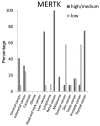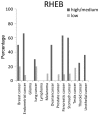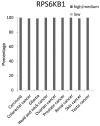Analysis of PI3K pathway components in human cancers
- PMID: 27073576
- PMCID: PMC4812578
- DOI: 10.3892/ol.2016.4309
Analysis of PI3K pathway components in human cancers
Abstract
Recent advances in genomics, proteomics, cell biology and biochemistry of tumors have revealed new pathways that are aberrantly activated in numerous cancer types. However, the enormous amount of data available in this field may mislead scientists in focused research. As cancer cell growth and progression is often dependent upon the phosphoinositide 3-kinase (PI3K)/AKT pathway, there has been extensive research into the proteins implicated in the PI3K pathway. Using data available in the Human Protein Atlas database, the current study investigated the expression of 25 key proteins that are known to be involved with PI3K pathway activation in a distinct group of 20 cancer types. These proteins are AKTIP, ARP1, BAD, GSK3A, GSK3B, MERTK-1, PIK3CA, PRR5, PSTPIP2, PTEN, FOX1, RHEB, RPS6KB1, TSC1, TP53, BCL2, CCND1, WFIKKN2, CREBBP, caspase-9, PTK2, EGFR, FAS, CDKN1A and XIAP. The analysis revealed pronounced expression of specific proteins in distinct cancer tissues, which may have the potential to serve as targets for treatments and provide insights into the molecular basis of cancer.
Keywords: AKT; EGFR; Human Protein Atlas; PI3K; PTEN; TSC1; cancer; tumorigenesis.
Figures










References
-
- Ocana A, Vera-Badillo F, Al-Mubarak M, Templeton AJ, Corrales-Sanchez V, Diez-Gonzalez L, Cuenca-Lopez MD, Seruga B, Pandiella A, Amir E. Activation of the PI3K/mTOR/AKT pathway and survival in solid tumors: Systematic review and meta-analysis. PLoS One. 2014;9:e95219. doi: 10.1371/journal.pone.0095219. - DOI - PMC - PubMed
LinkOut - more resources
Full Text Sources
Other Literature Sources
Research Materials
Miscellaneous
